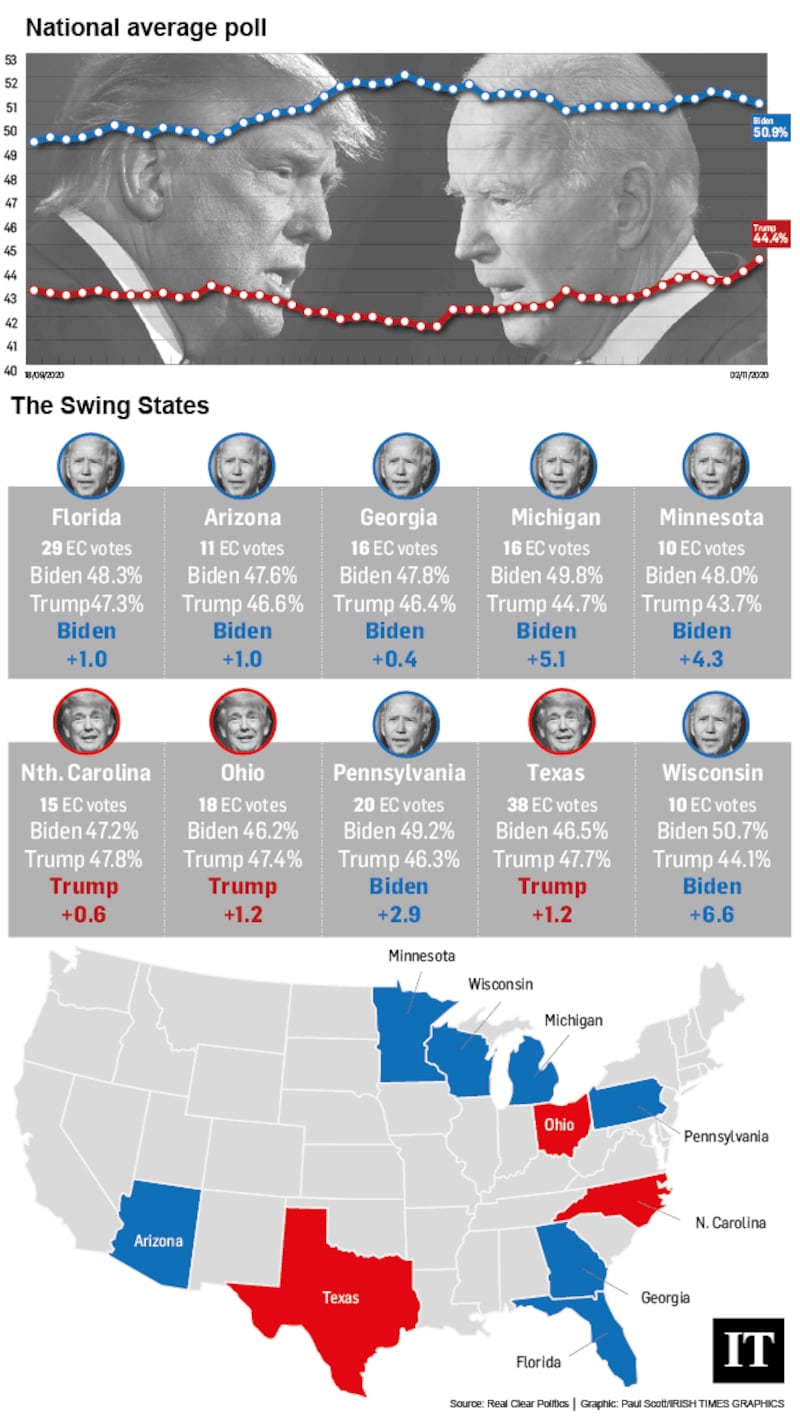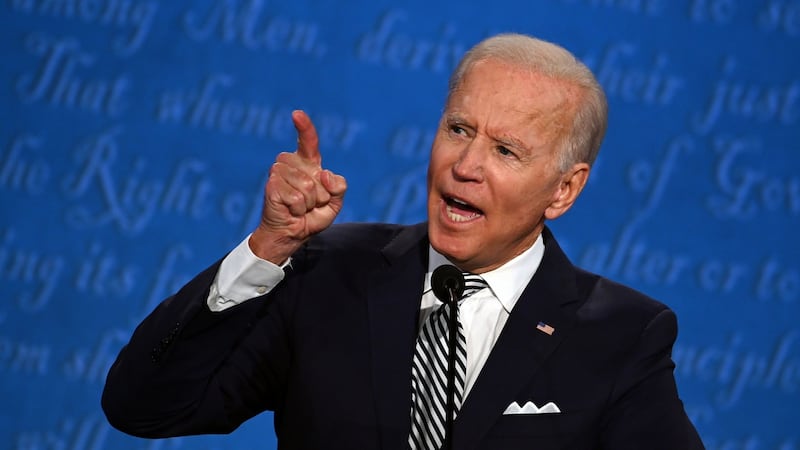US election day has arrived, with polls showing Democratic candidate Joe Biden with a decisive lead in the popular vote. But with the memory of Donald Trump's 2016 win still fresh, analysts, campaign operatives and media organisations are wary of putting too much store in polling.
Overall, polls have tightened in recent weeks, with the average of national polls run by Real Clear Politics putting Biden's lead nationally at just under seven percentage points.
Though chastened by the experience of 2016, Democrats are quietly confident that their candidate’s lead is solid. One reason is an improvement in the accuracy of polls compared to four years ago.

The Trump campaign needs a rapid turnaround in fortunes if he is to secure a second term
This time, pollsters are taking more account of the education levels of respondents – an omission in 2016 that many believe led to an underestimation of Trump’s support among voters without a college degree in the rust-belt states that helped win him the election.
Another change from 2016 is that Biden's lead has been pretty constant since the Democratic Party coalesced around his nomination in April. The polling has been more consistent than in the 2016 cycle, when support ebbed and flowed as voters responded to the latest news development, such as the Access Hollywood tapes that exposed Trump's comments about women, or former FBI director James Comey's announcement that he was re-examining Hillary Clinton's emails.
Four years later most voters made up their minds early, and there are fewer undecided voters.
The idiosyncrasies of the US electoral college system mean that Biden can of course win the popular vote – and indeed win by a much greater margin than Clinton did in 2016 – and still lose to Trump. Consequently, a more accurate predictor of the electoral race is the polling in a handful of swing states.

Here, Trump is also trailing but by much narrower margins than the national picture, suggesting that the races are tighter. Much focus on election night will be on the trio of rust-belt states – Michigan, Wisconsin and Pennsylvania – that swung Republican in 2016.
Biden is leading in all three, but Pennsylvania is the biggest prize with 20 electoral college votes.
Twenty years after the Al Gore v George W Bush race went down to the wire in Florida, the Sunshine State remains as significant as ever. Biden is ahead slightly, according to polls, amid signs that Trump's support among over-65s is slipping.
Democrats are hoping to also make gains in traditionally red states like Georgia, Arizona and even Texas this year – flipping any of those would represent a complete reconfiguration of the electoral map.
Republicans, conversely, see opportunities in smaller states like New Hampshire and Maine where there is strong support for Trump in rural areas.
With 270 electoral college votes needed to win the election, the race will come down to several swing states that will make or break the candidates.

Michigan
(16 electoral college votes)
Democrats are confident they can win back the Great Lakes state. Of the trio of rust-belt states – Michigan, Pennsylvania and Wisconsin – that flipped to Trump in 2016, he won Michigan by the smallest margin. Just 10,000 votes separated him from Hillary Clinton – a miniscule win in a state of approximately 10 million people.
Anecdotally, Clinton was an unpopular candidate in Michigan, with many Democratic voters casting their vote for Democrats down the ballot on election day but leaving their presidential choice blank. Biden has highlighted the role he played in the auto industry bailout a decade ago in campaign visits to the state. A strong turnout in Detroit is key to success here for Democrats, as Trump remains popular in the north and rural parts of the state. The latest RCP poll of polls puts Biden just over five points ahead.
[ Read Michigan profileOpens in new window ]
Florida
(29 electoral college votes)
Florida is a must-win state and both candidates have been campaigning heavily here in the final weeks. Traditionally north and central Florida are solid ground for Republicans and Trump remains popular, though a big Democratic vote in Miami-Dade County and around the cities of Orlando and Tallahassee is expected.
Polling suggests that Biden has a challenge with Latino voters in the state, who have warmed to Trump's anti-socialism message in light of their own, sometimes direct, experience of living in socialist states like Cuba and Venezuela. However, Trump's support among seniors has fallen dramatically – a problem in a state where one in five voters is over 65. Polls show that the race in Florida remains tight, and this contest could go down to the wire.
[ Read Florida profileOpens in new window ]
Pennsylvania
(20 electoral votes)
With 20 electoral votes, Pennsylvania is the most valuable of the three midwest states that Trump captured in 2016. Biden has home-town advantage here – he was born and raised in Scranton, a working-class town in the east of the state. Polls have consistently put Biden ahead but Trump has targeted the state heavily in the final days. Democrats are hoping that a strong turnout in Philadelphia and Pittsburgh will outweigh support for Trump in rural counties, particularly in central and western Pennsylvania. All eyes will be on three counties in particular – Erie, Luzerne and Northampton – that voted for Barack Obama but swung to Trump in 2016.
[ Read Pennsylvania profileOpens in new window ]

Wisconsin
(10 electoral college votes)
The third of Trump’s rust-belt successes four years ago. Clinton’s ill-fated decision not to visit the state still haunts Democrats, and the party chose Milwaukee as the location for its national convention before coronavirus necessitated a virtual-only affair. Although Wisconsin had voted Democrat in every election since 1988, in fact it has always been a closely-fought state running razor-tight margins in presidential elections.
Much focus will be on the suburbs of Milwaukee, which have been reliably Republican for years, even as the city itself has voted Democrat. But there is a new dimension this year. The state has been at the centre of protests and counter-protests over racial justice following the shooting of Jacob Blake in Kenosha in August. The Trump campaign is hoping its law and order message will play well in the state, though Biden has been polling well ahead.
[ Read Wisonsin profileOpens in new window ]
Arizona
(11 electoral college votes)
The southwestern state that shares a border with Mexico is one of a number of so-called sun-belt states through which Democrats see a path to victory for their candidate. A large Hispanic community, coupled with huge demographic changes as out-of-staters flock to the greater Phoenix area attracted by low taxes and business opportunities, is changing the political hue of the state.
In the congressional race the county to watch on election night is Maricopa County, which encompasses the greater Phoenix area and represents 64 per cent of all votes cast in the state. Mark Kelly, the husband of former congresswoman Gabby Giffords, who survived a gun shooting in 2010, is mounting a strong campaign against Republican incumbent Martha McSally – the woman appointed to fill the Senate seat of John McCain. Should Kelly win, Arizona would have two Democratic senators in Washington for the first time in 70 years.
[ Read Arizona profileOpens in new window ]
Minnesota
(10 electoral college votes)
The Trump campaign has been bullish about its candidate's prospects in this midwestern state since this summer, unnerving Democrats. Minnesota last went for a Republican president in 1972 when the state backed Richard Nixon, and Democrats have long seen the state as comfortable territory. But Trump has expressed regret that he didn't visit the state a few more times in 2016 as he believes he could have won here.
The rural-urban divide that increasingly drives political trends in America is in sharp relief in Minnesota. The Twin Cities area of Minneapolis and St Paul is reliably Democrat with an incredibly diverse population, including a big population of Somali-Americans. Among them is congresswoman Ilhan Omar, who represents the district.
But Trump’s support is strong in rural counties and in the so-called Iron Range near the Canadian border, which has shifted from Democrat to Republican in recent years. Concerns about racial justice and law and order are featuring heavily in the campaign this year following George Floyd’s killing in Minneapolis on May 28th, sparking global protests.
Campaigning here just days before his Covid-19 diagnosis, Trump told a rally in north Michigan that Joe Biden would “flood” the state with refugees if he wins the election.
[ Read Minnesota profileOpens in new window ]
Texas
(38 electoral college votes)
Democrats have long hoped that demographic changes will eventually mean that Texas turns blue, though whether this will be the year is far from certain. With 38 electoral college votes, the country's second-largest state is a huge electoral prize for any presidential candidate. Democrats have increased their ad spending in the state, suggesting they believe it could be in play. Female voters in the populous suburbs around Dallas and Houston could hold the key to the election outcome, amid evidence that moderate Republican women strongly oppose Trump. Nonetheless, Democrats remain cautious following the experience of the 2018 midterms. Despite the energy around former congressman Beto O'Rourke's Senate race against incumbent Ted Cruz, he did not clinch the seat, suggesting that talk of a blue wave was premature.
[ Read Texas profileOpens in new window ]

Georgia
(16 electoral college votes)
The southern state has long been reliably Republican territory, but Democrats are hopeful of success. Although Trump won the state by five points in 2016, Joe Biden’s popularity with the African-American community should play well in a state in which about a third of the population is black.
Again, Republicans face a challenge in the suburbs. Almost half of the state's votes came from the greater Atlanta region in 2016, and polls suggest that Trump is unpopular here. A drive to increase voter participation among the African-American community, led by 2018 gubernatorial candidate Stacey Abrams, could pay dividends for Democrats. The Real Clear Politics average of polls for the state has Biden slightly ahead, at 0.4 percentage points.
[ Read Georgia profileOpens in new window ]
North Carolina
(15 electoral college votes)
North Carolina has become increasingly competitive in recent years. Barack Obama won in 2008 but lost to Mitt Romney here in 2012. Trump defeated Clinton by just over 3 percentage points in the last election. A strong Democratic vote around the so-called triangle area anchored in the top universities in the Raleigh-Durham area was not enough to outweigh Republican support in the state's more rural areas, though Democrats also saw high turnout in the suburbs of Charlotte. The Real Clear Politics average has Trump ahead by 0.6 points.
The state also has a closely-watched Senate race between Republican Thom Tillis and Democratic challenger Cal Cunningham. Tillis contracted Covid-19 after attending the Amy Coney Barrett nomination event at the White House on September 26th, while Cunningham was revealed to have been texting a woman who was not his wife. It promises to be an interesting contest.
[ Read North Carolina profileOpens in new window ]
Ohio
(18 electoral college votes)
Ohio has long been a bellweather state – in 29 of the past 31 elections, whoever won the state gained the White House, and no Republican candidate has ever won without success here. Its status as a swing state, however, has been open to dispute, as it has leaned more comfortably Republican in recent years.
The latest Real Clear Politics average has Trump ahead by 1.2 percentage points. Biden is hoping that strong turnout in the cities and suburbs around Cleveland, Cincinnati and Columbus could flip the state for him on November 3rd.
[ Read Ohio profileOpens in new window ]

Five other races to watch:
Montana
(3 electoral college votes)
A traditionally Republican state that Trump won by 20 points in 2016. However, one of the state's two Senate seats is on the ballot, with former Democratic governor Steve Bullock challenging incumbent Steve Daines for the seat.
Maine
(4 electoral college votes)
Hillary Clinton won Maine by less than 3 points, and Republicans are hopeful they can win at least two of the state's four electoral college votes, which are distributed differently than in other states. The big focus here, however, is the Senate race, with Republican incumbent Susan Collins facing a challenge from Democrat Sara Gideon.
New Hampshire
(4 electoral college votes)
Clinton won New Hampshire by fewer than 3,000 votes in 2016 and Trump is hoping to flip the state. Though it only has four electoral votes, it could become important if the election is tight.
Iowa
(6 electoral college votes)
Trump clocked up a comfortable 10-point win in Iowa in 2016 but the latest RCP poll average has Trump 1.4 points ahead. There is also a Senate seat up for grabs, with Republican incumbent Joni Ernst under pressure to keep her seat.
South Carolina
(9 electoral college votes)
South Carolina voted for Trump by nearly 15 percentage points in 2016, and the state generally leans Republican. Senator Lindsey Graham faces an unexpectedly tough Senate challenge from Democrat Jaime Harrison.












